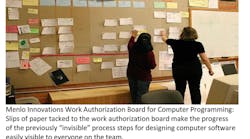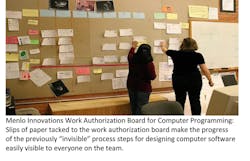Lean is Even More Important in Services than Manufacturing
If you are part of a service organization, how often have you heard someone say, “We can’t do lean here. Lean is just for manufacturing, isn’t it? We’re not some kind of widget-making assembly line, putting one piece onto another every 10 seconds! Our processes are long and complex; every transaction is unique and requires special consideration. And besides, most of the work we do takes place in our peoples’ minds and behind their computer screens. There’s no possible way we could use lean here.”
Having spent many years helping different types of service organizations implement lean, you can imagine how many times I have heard a version of this statement. And over the years, what I have come to realize is that it is precisely because service processes do tend to have long cycle times (think quarterly payroll tax processes), many complex variables, multiple decision points and interactions with a variety of computer systems (think putting someone on a short-term disability leave of absence) and much of the value-added work does often take place out of sight, in peoples’ minds (think call center reps answering complicated HR-related questions) that makes lean philosophy and tools a great fit—and can be of huge benefit—for services industries. Since service processes are not physically observable, especially useful are tools like visual management that make otherwise invisible work processes visible, and techniques that specifically develop a team member’s creative problem-solving and critical thinking abilities to the fullest.
If your service organization currently doesn’t practice lean, and you don’t believe me, try this little experiment: Find a team that does similar work, such as entering customer transactions or answering customer calls. Give each team member a different colored pad of post-it notes and choose one particular process all team members complete regularly. Ask each team member to write the series of steps that he or she takes to do the work on a separate post-it note. Once all have completed their post-its, have each team member stick their series of notes—one row for each team member, one above the other—onto a large piece of paper or a whiteboard.
Oh, and by the way, make sure to ask the team beforehand if they think each of them is completing the sequence of steps the same way. I assure you that they will all say that they are positive they are doing the same set of steps, and that all the rows of post-it notes will be the same length and contain the same number of steps performed in the same order.
After completing the exercise, take a step back, and take a look. I can absolutely guarantee that none of the rows will be the same length, or have the same steps in the same order.
And this is precisely why it is even more important for service organizations—with long, complex, variable processes with multiple decision points—to use the tools that lean gives us to make processes that take place inside people’s heads visible. If all of your team members aren’t doing the work in the same way, each and every time, how can you guarantee that your customers are getting consistent high-quality services each and every time? And if your team members aren’t constantly pushing their critical thinking skills to improve the process, how can you guarantee that they will be able to respond to increasing levels of complex service requests interacting with multiple departments and complicated systems to make the right decisions to satisfy your customers and keep them from going to the competition?
Now you can use this same post-it note exercise to develop a visible standard process for doing the work shown by person. You can estimate times for tasks and establish a daily cadence for work. When there are deviations between what you expect to happen and what does happen, you have an opportunity for improving the process.
Lean isn’t about manufacturing. It is about standardizing work processes to make problems visible and developing your team members’ critical thinking ability so that they can solve those problems and improve work processes. So the next time someone in your service organization tries to tell you that “lean is just for manufacturing,” you’ll know better.
______________________________________________________________________
Liker Leadership Institute (LLI) offers an innovative way to learn the secrets of lean leadership through an online education model that is itself lean, and extends that lean education far beyond the course materials. Learn more about LLI's green belt and yellow belt courses in "The Toyota Way to Lean Leadership" and "Principles of Lean Thinking" at the IndustryWeek Store.





